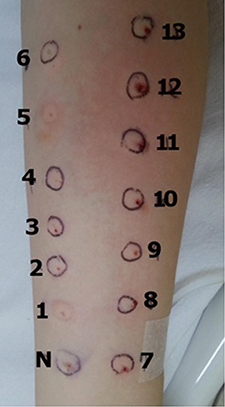Asia Pac Allergy.
2016 Oct;6(4):253-256. 10.5415/apallergy.2016.6.4.253.
Bepotastine-induced urticaria, cross-reactive with other antihistamines
- Affiliations
-
- 1Department of Otorhinolaryngology, Jeju National University School of Medicine, Jeju, Korea.
- 2Regional Pharmacovigilance Center, Jeju National University Hospital, Jeju, Korea. doc4u@hanmail.net
- 3Department of Internal Medicine, Jeju National University School of Medicine, Jeju, Korea.
- KMID: 2397022
- DOI: http://doi.org/10.5415/apallergy.2016.6.4.253
Abstract
- Second-generation antihistamines are widely prescribed for the control of symptoms of allergic inflammation such as itchy hives, coryza, and itchy eyes. In rare circumstances, these drugs might provoke allergic inflammation. Hypersensitivity to bepotastine besilate, a second-generation antihistamine has never been reported. A 17-year-old schoolgirl, whose paroxysmal itchy hives had been controlled with bepotastine, experienced aggravation of the hives. An oral provocation test confirmed her hypersensitivity to bepotastine and cross-reactivity to levocetirizine. She showed no reaction to chlorpheniramine, ketotifen, or olopatadine among the 13 antihistamines tested. While searching for an antihistamine to control her itchy hives, we found that she also exhibited cross-reactivity to various antihistamines with different chemical structures from that of bepotastine, which is not predicted according to the chemical classification of antihistamines. We report a case of hypersensitivity to bepotastine besilate in a patient with chronic spontaneous urticaria.
MeSH Terms
Figure
Cited by 1 articles
-
Greetings from Asia Pacific Allergy
Yoon-Seok Chang
Asia Pac Allergy. 2016;6(4):195-197. doi: 10.5415/apallergy.2016.6.4.195.
Reference
-
1. Williams JI, Gow JA, Klier SM, McCue SL, Salapatek AM, McNamara TR. Non-clinical pharmacology, pharmacokinetics, and safety findings for the antihistamine bepotastine besilate. Curr Med Res Opin. 2010; 26:2329–2338.
Article2. Simons FE, Akdis CA. Histamine and H1 antihistamines. In : Adkinson NF, Bochner BS, Burks AW, Busse WW, Holgate ST, Lemanske RF, editors. Middleton's allergy: principles and practice. Philadelphia (PA): Elsevier Saunders;2013. p. 1503–1533.3. Rodríguez del Río P, González-Gutiérrez ML, Sánchez-López J, Nuñez-Acevedo B, Bartolomé Alvarez JM, Martínez-Cócera C. Urticaria caused by antihistamines: report of 5 cases. J Investig Allergol Clin Immunol. 2009; 19:317–320.4. Karamfilov T, Wilmer A, Hipler UC, Wollina U. Cetirizine-induced urticarial reaction. Br J Dermatol. 1999; 140:979–980.
Article5. Inomata N, Tatewaki S, Ikezawa Z. Multiple H1-antihistamine-induced urticaria. J Dermatol. 2009; 36:224–227.
Article6. Calista D, Schianchi S, Morri M. Urticaria induced by cetirizine. Br J Dermatol. 2001; 144:196.
Article7. Kim YU, Lee J. Drug hypersensitivity to various antihistamines with cross-reactions. Allergy Asthma Respir Dis. 2014; 2:134–137.
Article8. Lee SW, Byun JY, Choi YW, Myung KB, Choi HY. Fexofenadine-induced urticaria. Ann Dermatol. 2011; 23:Suppl 3. S329–S332.
Article9. Choi GS, Sung JM, Lee JW, Park HJ, Ye YM, Nahm DH, Park HS. Two cases of urticaria induced by ebastine. Korean J Asthma Allergy Clin Immunol. 2009; 29:64–68.10. Kim MY, Jo EJ, Chang YS, Cho SH, Min KU, Kim SH. A case of levocetirizine-induced fixed drug eruption and cross-reaction with piperazine derivatives. Asia Pac Allergy. 2013; 3:281–284.
Article11. Chang YS, Kwon HS, Cho SH, Kim YY, Min KU. A case of urticaria induced by both hydroxyzine and cetirizine but not by levocetirizine. Allergy. 2007; 62:819–821.
Article



